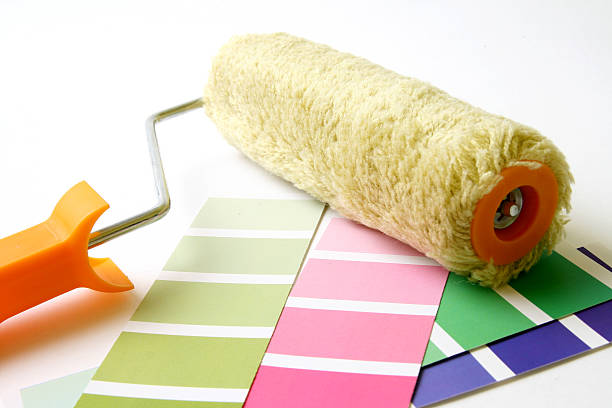Painting a room is not easy, especially if you’re new to DIY projects. Choosing a paint roller or a paintbrush is one of your most significant decisions. Both tools have their benefits, but we’ll discuss the advantages of using a paint roller vs a paintbrush in this article.

Firstly, let’s define what a paint roller and paintbrush are.
Paint Roller and Paintbrush
A paint roller is a tool with a handle and a cylinder covered in a textured material (usually foam or nap) used to apply paint to a surface. On the other hand, a paintbrush is a tool with a handle and bristles made of synthetic or natural fibres that apply paint to a surface.
The Advantages of Using A Paint Roller
We’ve understood each tool. Let’s dive into the advantages of using a paint roller.

Speed and Efficiency
Using a paint roller can save you much time and effort compared to using a paintbrush. This is because a paint roller covers a larger surface area with each stroke than a paintbrush, allowing you to apply more paint in less time. Additionally, a paint roller can apply paint more evenly than a paintbrush, so you’ll spend less time going over the same area multiple times to achieve the desired coverage.
Smooth Finish
Paint rollers are great for achieving a smooth, even finish on walls and ceilings. This is because the texture on the roller’s cylinder allows it to distribute the paint evenly across the surface, minimizing the appearance of brush strokes or roller marks. This is particularly important when painting larger surfaces, as any inconsistencies will be more noticeable.
Versatility
Paint rollers are versatile tools used on various surfaces, including walls, ceilings, floors, and furniture. They come in different sizes and textures so that you can choose the right roller for the job. For example, a foam roller is ideal for painting smooth surfaces, while a nap roller is better for textured surfaces.
Easy to Use
Paint rollers are easy to use, even if you’re a beginner. All you need to do is load the roller with paint and start rolling it over the surface you want to paint. You can even attach an extension pole to the handle of the roller to reach high or hard-to-reach areas without climbing a ladder.
The Advantages of Using A PaintBrush
We’ve covered the advantages of using a paint roller. Let’s look at the advantages of using a paintbrush.

Precision
Paintbrushes are great for achieving precision when painting. This is because you can control the amount of paint you apply to the surface, allowing you to create clean lines and sharp edges. This is particularly important when painting trim or other areas that require a high level of detail.
Flexibility
Paintbrushes are flexible tools used on various surfaces, including small or hard-to-reach areas a paint roller may not reach. Also, paintbrushes come in different sizes and shapes so that you can choose the right brush. For example, a small brush is ideal for painting narrow areas, while an angled brush is better for painting corners or edges.
Accessible to Clean
Paintbrushes are easy to clean and can be reused multiple times if handled correctly. You only need to rinse the brush with water or solvent (depending on the paint type) and let it dry before storing it.
Control
Paintbrushes give you more control over the paint application, allowing you to create different textures and effects. For example, you can use a dry brush technique to create a stippled effect or a wet brush technique to create a combined effect. Additionally, you can use a paintbrush to create different patterns or designs, adding a unique touch to your project.
While both paint rollers and paintbrushes have advantages, it’s important to consider the specific needs of your project when deciding which tool to use. If you’re painting a large surface area, such as a wall or ceiling, a paint roller may be the best choice for its speed and Efficiency. However, a paintbrush may be better if you paint a smaller area or require precision.
It’s also worth noting that you can use both tools in conjunction with each other to achieve the best results. For example, you can use a paint roller to cover a large surface area and then use a paintbrush to touch up any areas that require more precision.
So, the advantages of using a paint roller vs a paintbrush ultimately come down to the specific needs of your project. However, some general advantages of using a paint roller include speed and Efficiency, a smooth finish, versatility, and ease of use. In contrast, the advantages of using a paintbrush include precision, flexibility, ease of cleaning, and control over paint application. Considering these factors, you can decide which tool to use for your next painting project.
How to Choose the Right Paint Roller or Paint Brush?

When choosing the right paint roller or paint brush, it’s also essential to consider the quality of the tool. A high-quality tool can make a big difference in the final result of your project, as it will be easier to use and distribute the paint more evenly.
When selecting a paint roller, look for a durable, comfortable handle. The cylinder should also be made of a high-quality material that will not shed fibres or leave streaks. Additionally, consider the nap length of the roller, as this will determine the texture of the finish. For smooth surfaces, a short nap is ideal, while for textured surfaces, a longer nap is better.
When selecting a paintbrush, look for a comfortable handle that is easy to grip. The bristles should have high-quality fibres that will not shed or become misshapen after multiple uses. Additionally, consider the size and shape of the brush, as this will determine its suitability for different areas of your project.
When choosing between a paint roller and a paintbrush, it’s important to consider the type of surface you will be painting. A paint roller is typically the best choice for smooth surfaces, such as walls or ceilings. However, a paintbrush may be better for painting a textured or uneven surface.
Additionally, the type of paint you are using can also play a role in determining which tool to use. For example, if you use thick or heavy paint, such as oil-based paint, a paintbrush may be easier to use than a roller. On the other hand, if you are using thin or runny paint, such as latex, a roller may be the better choice.
Another factor to consider is the size of the project. A paint roller is the most efficient choice for large surface areas, such as a room or an entire house. However, a paintbrush may be better for greater precision and control if you paint a small area, such as trim or a corner.
When painting a room, there are a few additional tips and tricks to remember. First, prep the surface properly by cleaning it thoroughly and repairing any cracks or holes. This will ensure the paint adheres properly and provides a smooth finish.
Next, choose the right type of paint for your project. Many different types of paint are available, each with advantages and disadvantages. Be sure to choose the appropriate paint for the surface you will be painting and the durability and sheen you desire.
Maintenance of Your Paint Rollers and Paintbrushes

In terms of maintenance, cleaning your paint rollers and paintbrushes after each use is essential to ensure their longevity. Rinse paint rollers with warm water and use a roller cleaner to remove any excess paint. For paintbrushes, rinse them with warm water or solvent, depending on the type of paint you’re using. Use a brush cleaner to remove any excess paint and reshape the bristles before allowing them to dry.
Then both paint rollers and paintbrushes have their advantages and disadvantages. While paint rollers are generally faster and more efficient for larger surface areas, paintbrushes offer more precision and control. The key is to choose the right tool for your specific project and to select high-quality tools that will provide a smooth and even finish. By following these guidelines, you can achieve professional-looking results that you’ll be proud of.
Tips and Tricks
In addition to the advantages of using a paint roller vs a paintbrush, you can also use some tips and tricks to ensure the best possible outcome for your project.
One important factor to consider is the type of paint you are using. Certain types of paint, such as gloss or semi-gloss, may require a specific type of tool or technique to achieve the desired finish. Additionally, if you are painting a surface that has already been painted, it’s important to prime the surface first to ensure the new coat of paint adheres properly.
Another factor to consider is the direction in which you apply the paint. When using a paint roller, it’s best to work in a “W” pattern, rolling the roller back and forth to ensure even coverage. For paintbrushes, it’s essential to work in the direction of the grain or texture of the surface, using long, smooth strokes to prevent streaks.
It’s also essential to use the right amount of paint. Too much paint can result in drips and uneven coverage, while too little paint can result in a patchy finish. The key is to use consistent paint, working in small sections and allowing each section to dry before moving on to the next.

Finally, paying attention to the environmental conditions you are painting is important. Humidity and temperature can affect the drying time and finish of the paint, so it’s essential to choose a day when the conditions are ideal. Additionally, it’s important to ensure proper ventilation to prevent the buildup of fumes and odours.
The advantages of using a paint roller vs a paintbrush ultimately come down to the specific needs of your project. While paint rollers are generally faster and more efficient for larger surface areas, paintbrushes offer more precision and control. By choosing the right tool for your specific project and following these tips and tricks, you can achieve professional-looking results that you’ll be proud of.
Paint Roller vs Paint Brush
Paint Roller
Paint rollers are excellent for large surface areas like walls or ceilings. They are fast, efficient, and can cover a lot of ground in a short amount of time. Additionally, paint rollers are versatile and can be used with various types of paint, from latex to oil-based. This means you can use the same tool for multiple projects, making them a cost-effective option.
One of the most significant advantages of using a paint roller is that they provide a smooth, even finish. The cylindrical shape of the roller allows the paint to be distributed evenly, resulting in a consistent finish. This is especially important for larger surface areas, as achieving an even finish with a paintbrush alone can be challenging.
Another advantage of using a paint roller is that they are easy to use. Load the roller with paint, and roll it onto the surface in a “W” pattern. Because the roller covers a large area with each stroke, you can complete the project quickly and efficiently. This is especially helpful if you are painting a room in your home and want to minimize the disruption to your daily routine.
Paint Brush
Regarding paintbrushes, the advantages are more focused on precision and control. Paintbrushes are ideal for smaller surface areas, such as trim or corners, where a roller cannot reach. Additionally, paintbrushes are great for creating a blended effect or adding texture to a surface.
One of the most significant advantages of using a paintbrush is that it allows for greater precision and control. This is especially important when working on smaller surface areas, as achieving a clean, crisp line with a paint roller can be difficult. Additionally, paintbrushes can create different patterns or designs, adding a unique touch to your project.
Another advantage of using a paintbrush is that they are flexible and can be used in various ways. For example, you can use a small paintbrush to touch up areas the roller may have missed or a larger brush to cover a larger surface area. This versatility makes paintbrushes a valuable tool for any painting project.
One of the key advantages of using a paintbrush is the ease of cleaning. Unlike paint rollers, which can be challenging to clean, paintbrushes can be rinsed with warm water or solvent, depending on the type of paint you are using. Additionally, paintbrushes can be stored easily, taking up less space than paint rollers.
Overall, the advantages of using a paint roller vs a paintbrush come down to the specific needs of your project. While paint rollers are generally faster and more efficient for larger surface areas, paintbrushes offer more precision and control. By considering these factors, as well as the type of paint you are using and the environmental conditions you are painting, you can choose the right tool for your project and achieve professional-looking results every time.
How to Use a Paint Roller

Prepare the surface you are painting.
This means cleaning the surface to remove dirt, debris, or flaking paint. You should apply painter’s tape to areas you don’t want to paint, such as trim, windows, or light fixtures.
Use the Proper Technique to Achieve an Even Finish
Start by dipping the roller cover into the paint and then rolling it back and forth on the paint tray to distribute it evenly. Then, use long, even strokes to roll the paint onto the surface, working from top to bottom. Be sure to overlap each stroke slightly to avoid leaving gaps or streaks.
When using a paint roller, use a high-quality roller cover to ensure an even finish. Roll the paint onto the surface in a “W” pattern to ensure even coverage. For paintbrushes, be sure to use the correct size brush for the area you are painting, and work in the direction of the grain or texture of the surface.
Allow the Paint to Dry
Allow the paint to dry completely before applying a second coat or touching any areas. This will ensure that the paint sets appropriately and provides a long-lasting finish.
In conclusion, the advantages of using a paint roller vs a paintbrush ultimately come down to the specific needs of your project. By considering the type of surface you will be painting, the type of paint you are using, and the project size, you can choose the right tool for the job. Additionally, by following these tips and tricks, you can always ensure a successful painting project.
Conclusion
In conclusion, the choice between using a paint roller or a paintbrush ultimately comes down to personal preference and the specific needs of your project. Both tools have advantages and disadvantages, and the right choice will depend on various factors, including the type of surface you are painting, the type of paint you are using, and the size of your project. By considering these factors and following these tips and tricks, you can choose the right tool for the job and achieve a beautiful, professional-looking finish for your next painting project.

